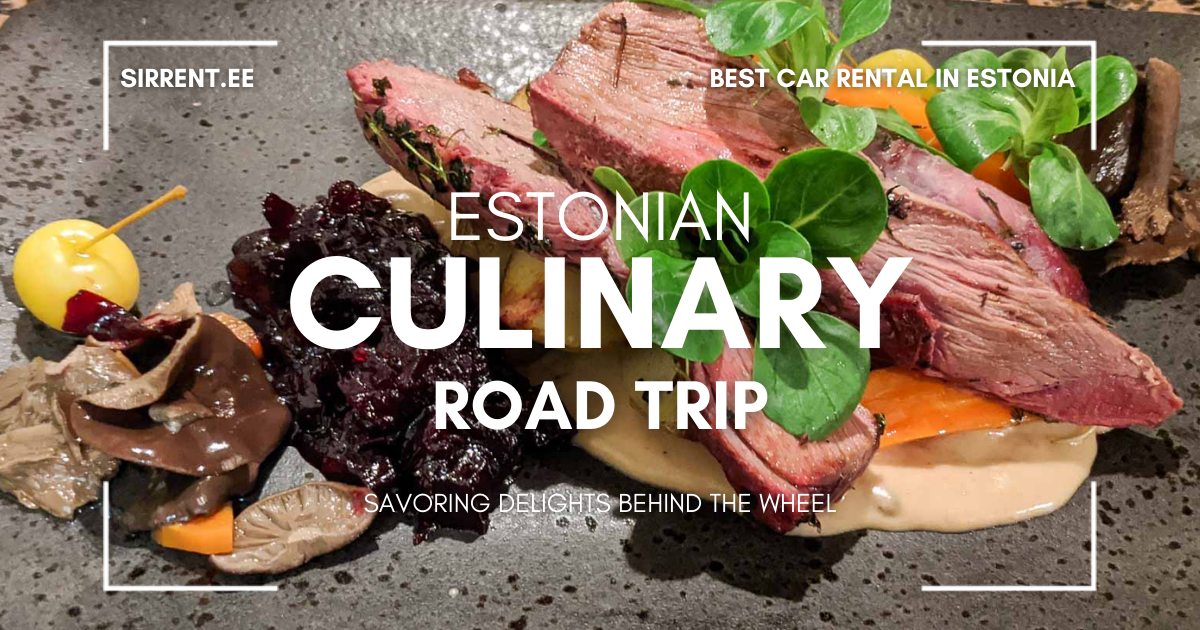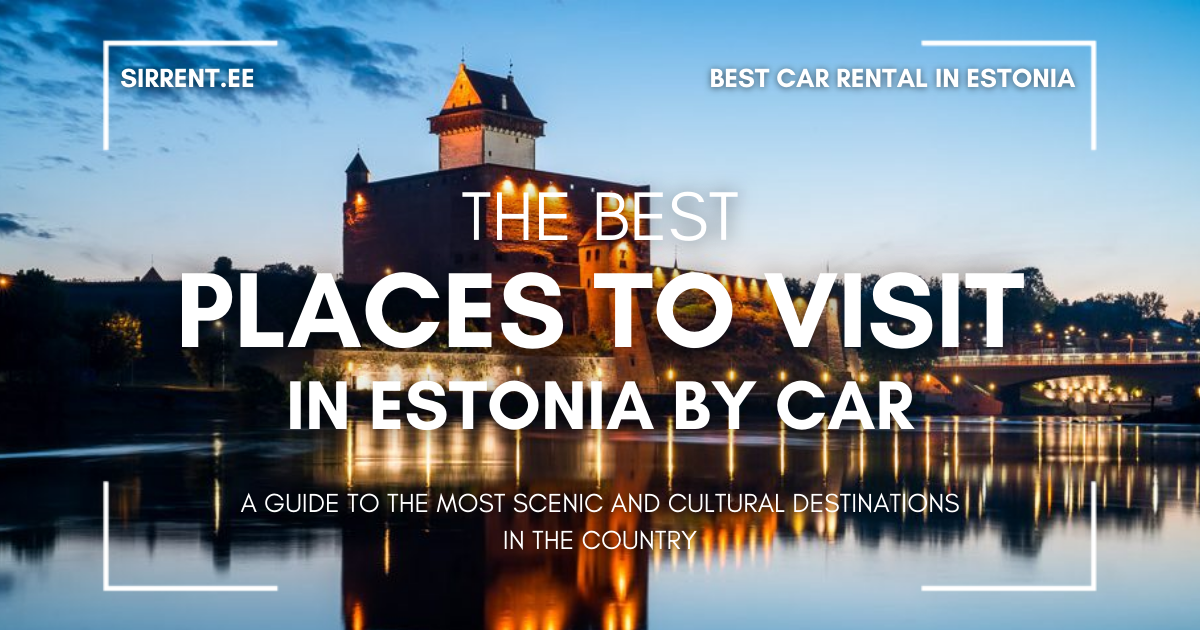When you think of Estonia, medieval castles, lush forests, and pristine coastlines likely come to mind. But did you know that Estonia also boasts a rich culinary heritage waiting to be discovered? Buckle up and join us on an unforgettable gastronomic adventure as we explore the flavors of this Baltic gem by car. The Journey Begins: Tallinn’s Food Scene Our culinary road trip kicks off in Tallinn, the capital city. As you pick up your rental car, consider grabbing a local snack—a kohuke (a sweet curd snack covered in chocolate) or a warm karask (traditional barley bread). Now, let’s hit the road! Tallinn’s Must-Try Eateries Olde Hansa: Step back in time at this medieval-themed restaurant. Feast on hearty dishes like wild boar stew and elk roast. Don’t forget the honey beer! Rataskaevu 16: A cozy cellar restaurant serving modern Estonian cuisine. Try the smoked eel, a delicacy that pairs perfectly with local craft beer. F-Hoone: Located in a former factory, F-Hoone offers an industrial-chic vibe. Order the black bread burger—a twist on the classic. Coastal Delights: Pärnu and Haapsalu As you drive westward, the Baltic Sea comes into view. Stop in Pärnu, Estonia’s summer capital, known for its sandy beaches and spa resorts. Here, indulge in: Smoked Fish: Sample freshly smoked fish from local markets. The sprat (small herring) is a favorite. Kohvik Supelsaksad: Enjoy coffee and cake at this charming beachfront café. Try the kama dessert, a blend of grains and yogurt. Continue to Haapsalu, a picturesque town with wooden houses and a historic castle. Don’t miss: Kohvik Promenaad: Sip sea buckthorn tea while gazing at the sea. Pair it with a slice of kohuke. Linnuse Kelder: Dine in a medieval cellar. Order the venison stew—a true taste of Estonia’s wild side. Island Vibes: Saaremaa Cross over to Saaremaa Island via a short ferry ride. Here, nature and flavors collide: Kuressaare Castle: Explore the castle grounds, then head to the Kuursaal Café for a slice of kama cake. Pädaste Manor: A luxurious manor-turned-hotel. Savor their smoked fish platter and homemade black bread. Wild Forests and Farmsteads: Lahemaa National Park Drive north to Lahemaa National Park, where dense forests meet the sea. Along the way: Altja Tavern: A rustic inn serving wild boar sausages and nettle soup. Pair it with a local craft cider. Palmse Manor: Tour the manor house and gardens. Stop by the café for a slice of kohupiimakook (curd cake). Parting Thoughts As your Estonian culinary road trip concludes, reflect on the flavors you’ve savored—the earthy rye bread, the tangy berries, and the warmth of local hospitality. Remember, the best way to experience Estonia’s cuisine is with the wind in your hair and the open road ahead. So, fellow foodies, rev up your engines, follow the aroma of freshly baked bread, and let Estonia’s culinary secrets unfold before you. Bon appétit! BEST CAR RENT IN TALLINN Remember to share your favorite food discoveries with us using #EstonianFoodRoadTrip, #sirrent! Happy travels! 🚗🍽️🇪🇪 Disclaimer: The information provided in this blog post is accurate as of the publication date. Always check for the latest updates and local recommendations. Get the Best Price for your rental Today!
The best places to visit in Estonia by car: a guide to the most scenic and cultural destinations in the country
Estonia is a small but diverse country in Northern Europe, with a rich history, stunning nature, and charming towns. It is also a great destination for a road trip, as you can easily explore its different regions and attractions by car. In this blog post, we will suggest some of the best places to visit in Estonia by car, and give you some tips on how to make the most of your journey. Tallinn Tallinn is the capital and largest city of Estonia, and a must-see for any visitor. It is famous for its well-preserved medieval Old Town, which is a UNESCO World Heritage Site and one of the most beautiful in Europe. You can walk along the cobblestone streets, admire the Gothic churches and towers, and visit the museums and galleries. You can also enjoy the modern side of Tallinn, with its trendy cafes, restaurants, and nightlife. Tallinn is a good starting point for your road trip, as you can easily rent a car and access the main highways from there. You can also take a ferry to Helsinki, Finland, or Stockholm, Sweden, if you want to extend your trip. Tartu Tartu is the second-largest city and the cultural and intellectual center of Estonia. It is home to the oldest and most prestigious university in the country, as well as many museums, theaters, and festivals. Tartu has a youthful and creative vibe, with a lot of street art, cafes, and pubs. It is also a good base for exploring the nearby nature, such as the Emajõgi River, the Lake Peipus, and the Endla Nature Reserve. Tartu is about 2.5 hours drive from Tallinn, and you can take the E263 highway or the scenic route along the coast. You can also stop by the Jägala Waterfall, the largest natural waterfall in Estonia, on your way. Saaremaa Saaremaa is the largest island in Estonia, and a popular destination for its rural charm, natural beauty, and historical sites. You can visit the Kuressaare Castle, the best-preserved medieval fortress in the Baltic States, the Kaali Meteorite Crater, the result of a massive impact about 4,000 years ago, and the Angla Windmill Park, a collection of traditional wooden windmills. You can also enjoy the sandy beaches, the pine forests, and the local cuisine, such as the smoked fish, the rye bread, and the juniper beer. Saaremaa is accessible by ferry from the mainland, and the journey takes about 30 minutes. You can also visit the neighboring island of Muhu, which is connected to Saaremaa by a causeway. Muhu is known for its traditional villages, handicrafts, and folklore. Parnu Parnu is the summer capital and the most popular seaside resort of Estonia. It has a long and wide sandy beach, with a promenade, a park, and a pier. You can swim, sunbathe, or try some water sports, such as surfing, sailing, or kayaking. You can also relax in one of the many spas, which offer a variety of treatments and therapies. Parnu also has a lively cultural scene, with many concerts, festivals, and events throughout the year. Parnu is about 2 hours drive from Tallinn, and you can take the E67 highway or the coastal road. You can also stop by the Soomaa National Park, a wetland area with diverse wildlife and plants. You can hike, bike, or canoe in the park, and see the phenomenon of the fifth season, when the water level rises and floods the land. Narva Narva is the easternmost city and the border town of Estonia, facing Russia across the Narva River. It is a fascinating place to visit for its historical and cultural significance, as well as its contrast between the two countries. You can see the Narva Castle, a 13th-century fortress that was the scene of many battles and sieges, and the Hermann Castle, a 15th-century castle that houses a museum and a gallery. You can also visit the Narva-Jõesuu, a resort town with a long and sandy beach, and the Narva Waterfall, the widest natural waterfall in Europe. Narva is about 3 hours drive from Tallinn, and you can take the E20 highway or the coastal road. You can also stop by the Lahemaa National Park, the largest and oldest national park in Estonia, which covers a large area of forests, bogs, lakes, and islands. You can see the manor houses, the fishing villages, and the wildlife in the park. Hiiumaa Hiiumaa is the second-largest island in Estonia, and a tranquil and scenic place to visit. It has a long and interesting history, as it was once a Swedish, Russian, and German territory. You can see the Kõpu Lighthouse, the oldest lighthouse in the world, the Kassari Chapel, a wooden church with a unique shape, and the Sõru Museum, a maritime museum that displays the local fishing and sailing culture. You can also enjoy the nature, such as the Ristna Cape, a popular spot for surfing and birdwatching, and the Kärdla Meteorite Crater, a large depression formed by an impact about 450 million years ago. Hiiumaa is accessible by ferry from the mainland, and the journey takes about 90 minutes. You can also visit the smaller islands of Kassari, Vormsi, and Ruhnu, which have their own attractions and charm. Viljandi Viljandi is a small and picturesque town in the south of Estonia, known for its cultural heritage and folk music. It hosts the annual Viljandi Folk Music Festival, one of the largest and most popular music festivals in the country, which attracts thousands of visitors and performers from around the world. You can also visit the Viljandi Castle, a 13th-century ruin that offers a panoramic view of the town and the lake, the Viljandi Museum, which showcases the local history and art, and the Heimtali Museum of Domestic Life, which displays the traditional rural life and crafts. Viljandi is about 2 hours drive from Tartu, and you can take the E264 highway or the scenic route through the forests and hills. You can also stop by





